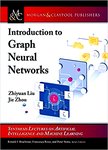版权所有:内蒙古大学图书馆 技术提供:维普资讯• 智图
内蒙古自治区呼和浩特市赛罕区大学西街235号 邮编: 010021

丛 书 名:Synthesis Lectures on Artificial Intelligence and Machine Learning
I S B N:(纸本) 9781681737676
出 版 社:Morgan & Claypool
出 版 年:2020年
主 题 词:information science \u0026 technology computer science information science \u0026 technology computer science
学科分类:12[管理学] 0711[理学-系统科学] 1201[管理学-管理科学与工程(可授管理学、工学学位)] 07[理学] 081104[工学-模式识别与智能系统] 08[工学] 0835[工学-软件工程] 081101[工学-控制理论与控制工程] 0811[工学-控制科学与工程] 0812[工学-计算机科学与技术(可授工学、理学学位)] 071102[理学-系统分析与集成] 081103[工学-系统工程]
摘 要:Graphs are useful data structures in complex real-life applications such as modeling physical systems, learning molecular fingerprints, controlling traffic networks, and recommending friends in social networks. However, these tasks require dealing with non-Euclidean graph data that contains rich relational information between elements and cannot be well handled by traditional deep learning models (e.g., convolutional neural networks (CNNs) or recurrent neural networks (RNNs)). Nodes in graphs usually contain useful feature information that cannot be well addressed in most unsupervised representation learning methods (e.g., network embedding methods). Graph neural networks (GNNs) are proposed to combine the feature information and the graph structure to learn better representations on graphs via feature propagation and aggregation. Due to its convincing performance and high interpretability, GNN has recently become a widely applied graph analysis *** book provides a comprehensive introduction to the basic concepts, models, and applications of graph neural networks. It starts with the introduction of the vanilla GNN model. Then several variants of the vanilla model are introduced such as graph convolutional networks, graph recurrent networks, graph attention networks, graph residual networks, and several general frameworks. Variants for different graph types and advanced training methods are also included. As for the applications of GNNs, the book categorizes them into structural, non-structural, and other scenarios, and then it introduces several typical models on solving these tasks. Finally, the closing chapters provide GNN open resources and the outlook of several future directions.